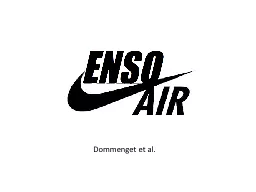PPT-Dommenget et al.
Author : olivia-moreira | Published Date : 2017-07-19
Overview The Slab Ocean El Nino How good are the CMIP models Nonlinearity Seasonality spring barrier CP vs EP Teleconnections delayed feedback Climate Change Overview
Presentation Embed Code
Download Presentation
Download Presentation The PPT/PDF document "Dommenget et al." is the property of its rightful owner. Permission is granted to download and print the materials on this website for personal, non-commercial use only, and to display it on your personal computer provided you do not modify the materials and that you retain all copyright notices contained in the materials. By downloading content from our website, you accept the terms of this agreement.
Dommenget et al.: Transcript
Download Rules Of Document
"Dommenget et al."The content belongs to its owner. You may download and print it for personal use, without modification, and keep all copyright notices. By downloading, you agree to these terms.
Related Documents

